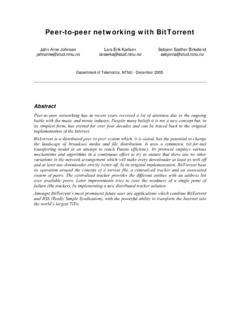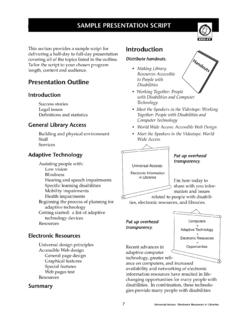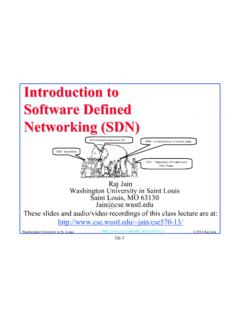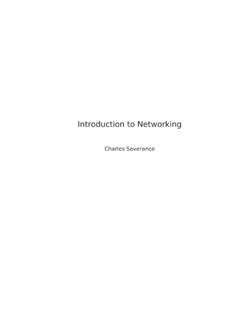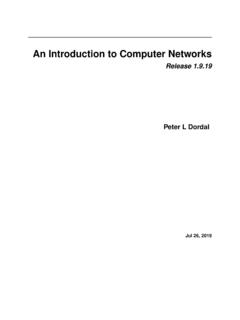Transcription of Introduction to WiFi Networking - Internet Society
1 Introduction toWiFi NetworkingMarco ZennaroErmanno PietrosemoliGoalsThe goal of this lecture is to introduce: family of radio protocols radio channels Wireless network topologies WiFi modes of operation Strategies for routing network traffic2 ISM / UNII bandsMost commercial wireless devices (mobile phones, television, radio, etc.) use licensed radio frequencies. Large organizations pay licensing fees for the right to use those radio uses unlicensed spectrum. License fees are not usually required to operate WiFi Industrial, Scientific and Medical (ISM) bands allow for unlicensed use of GHz, GHz, and many other (non-WiFi) family56 Wireless Networking protocols supports up to 54 Mbps using the 5 GHz unlicensed bands.
2 Supports up to 11 Mbps using the GHz unlicensed band. supports up to 54 Mbps using the GHz unlicensed band. supports up to 600 Mbps using the GHz and 5 GHz unlicensed family of radio protocols are commonly referred to as WiFi. (WiMAX) is not WiFi! It is a completely different technology that uses a variety of licensed and unlicensed of @ AC Two or up to 8 Spatial streams (MIMO) Higher order modulation types (up to 256 QAM) Wider Channels bandwidth (up to 160 MHz)8 Improved performance by means of:IEEE AC: MIMO9 IEEE AC, 256 constellation10 Data ratesNote that the data rates quoted in the WiFi specifications refer to the raw radio symbol rate, not the actual TCP/IP throughput rate.
3 The difference is called protocol overhead, and is needed by the WiFi protocol to manage collisions, retransmissions, and general management of the ratesA good rule of thumb is to divide the radio symbol rate by two to obtain the maximum practical TCP/IP throughput. For example, a 54 Mbps link has a maximum practical throughput of roughly 25 Mbps. An 11 Mbps link has a maximum throughput of about 5 offers a maximum theoretical data rate of 6 layer: CSMA vs. WiFi uses Carrier Sense Multiple Access (CSMA) to avoid transmission collisions. Before a node may transmit, it must first listen for transmissions from other radios. The node may only transmit when the channel becomes technologies (such as WiMAX, Nstreme, and AirMAX) use Time Division Multiple Access (TDMA) instead.
4 TDMA divides access to a given channel into multiple time slots, and assigns these slots to each node on the network. Each mode transmits only in its assigned slot, thereby avoiding oneTCP/IP Protocol Stack5 Application4 Transport3 Internet2 Data Link1 Physical Radio channel Radio operating mode Network name Security featuresWiFi devices must agree on several parameters before they can communicate with each other. These parameters must be properly configured to establish layer one WiFi WiFi ChannelsWiFi devices must use the same channel in order to communicate with each other. They send and receive on the same channel, so only one device may transmit at any time.
5 This kind of connection is called channels: 1, 6, 1118AP channel WiFi WiFi Channels21 Wireless network topologies Point-to-Point Point-to-Multipoint Multipoint-to-MultipointAny complex wireless network can be thought of as a combination of one or more of these types of connections:22 Point to PointThe simplest connection is the point-to-point link. These links can be used to extend a network over great to MultipointWhen more than one node communicates with a central point, this is a point-to-multipoint to MultipointWhen any node of a network may communicate with any other, this is a multipoint-to-multipoint network (also known as an ad-hoc or mesh network).
6 2526 WiFi radio modes in action2627 Routing WiFi provides a link-local connection. It does not provide any routing functionality! Routing is implemented by higher level Protocol Stack5 Application4 Transport3 Internet2 Data Link1 PhysicalWiFi}28 Bridged networkingFor a simple local area wireless network, a bridged architecture is usually adequate. Advantages Very simple configuration Roaming works very wellDisadvantages Increasingly inefficient as nodes are added All broadcast traffic is repeated Virtually unusable on very large wide-area networks29 Bridged access points30 Routed networkingLarge networks are built by applying routing between nodes.
7 Static routing is often used on point-to-point links. Dynamic routing (such as RIP or OSPF) can be used on larger networks, although they are not designed to work with imperfect wireless links. Mesh routing protocols work very well with wireless networks, particularly when using radios in ad-hoc networkingAs the network grows, it becomes necessary to use some sort of routing scheme to maintain traffic More complex configuration Roaming between APs is not supportedAdvantages Broadcast domains are limited, making more efficient use of radio bandwidth Arbitrarily large networks can be made A variety of routing protocols and bandwidth management tools are available32 Routed access points33A link is composed of many parts+AP settings: protocol channel TX power +cablesandantennaclient settings.
8 Protocol channel min RSSI cable loss antenna gain alignment polarization cable loss antenna gain alignment polarizationpath lossobstacles(Fresnel)clientstationacces spointFor more details about the topics presented in this lecture, please see the book Wireless Networking in the Developing World, available as free download in many languages at: you for your attentio







